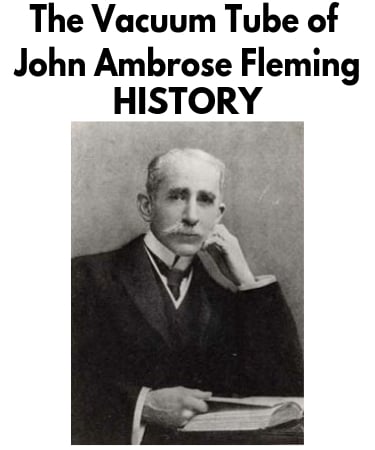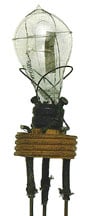Key Points About the Thermionic Tube:
- The Thermionic tube goes by many names, to include vacuum tubes, vacuum diodes, thermionic tubes, the Fleming valve, and kenotron.
- While the device has many names, the actual device only has three components. The device heats electrons, gives them away at one end of the tube, and receives them at the other end.
- Basically, the vacuum tube starts electrons moving and provides a direction to move.

Thermionic Tube History
The thermionic tube has gone by many names throughout the timeline of its life. It’s also known as and referred to as a vacuum tube, vacuum diode, Fleming valve, and kenotron. Sir John Ambrose Fleming (hence the name “Fleming valve”) invented the thermionic valve and was granted patent GB 24850 in 1904. While there had been computers prior to 1904, the invention of vacuum diodes allowed for the first generation computers to rely more heavily on electricity than they did mechanics. It would be almost half a century before thermionic tubes would be replaced by other technology (see the integrated circuit created by Robert Noyce and Jack Kilby), and many years after that for those technologies to become available to the common individual.

Thermionic Tube: How It Worked
Despite being a technological marvel at the time of its creation, the vacuum tube is a relatively simple design. If one were to look at a diagram of a traditional vacuum tube it would only consist of three components: an electrode, anode, and cathode. The cathode releases free electrons into the Fleming valve, the anode captures those electrons, and the electrode facilitates that transfer of energy. Basically, the device gets the electrons moving and gives them the proper direction in which to move.
Quick Facts
- Created
- The patent for the first thermionic tube (which would later be used in first generation computers) was issued in 1904 to one Sir John Ambrose Fleming.
- Creator
- Sir John Ambrose Fleming
- Original Use
- The thermionic tube utilizes electrical characteristics to allow the flow of free electrons from one end of the device to another. It’s a simple device whose diagram consists of just three components: an anode, cathode, and electrode.
- Cost
- The original cost of the vacuum tube is unknown.

Thermionic Tube: Historical Significance
Because of vacuum tubes, vacuum diodes, kenotrons, whatever someone wants to call them, technology would not be the same without them. The Fleming valve revolutionized how electricity could be transported within machines and technologies. The vacuum diode is so important to the history of technological advancements that without it several electronics would not have been possible: radios, televisions, radar technologies, etc. All of these relied on vacuum tubes to act as resistors and transport the correct amount of electricity to each electrical component they use. Even though vacuum tubes have since been replaced with integrated circuits to reduce the size and increase the lifetime of the parts, the kenotron paved the way for the creation of many technologies throughout the timeline of computers and other electronics.
Up Next…
Want to find out more about computer components and some history? Check these reads out below!
- Integrated Circuit (IC) Explained — Everything You Need to Know. Moving on from the vacuum tube, let’s take a look at the integrated circuit.
- How to Build a PC: All the Necessary Components. Ready to get your hands on some PC parts and get building? Start with this article.
- Floppy Disk Explained: Everything You Need to Know. The floppy disk was an experience in itself. Take a walk down memory lane with us on this read!
Want to Retire Early? Start Here (Sponsor)
Want retirement to come a few years earlier than you’d planned? Or are you ready to retire now, but want an extra set of eyes on your finances?
Now you can speak with up to 3 financial experts in your area for FREE. By simply clicking here you can begin to match with financial professionals who can help you build your plan to retire early. And the best part? The first conversation with them is free.
Click here to match with up to 3 financial pros who would be excited to help you make financial decisions.
